Sverige class coastal battleships (1915)
 Swedish Navy 1912-70
Swedish Navy 1912-70
HSwMS Sverige, Drottning Victoria, Gustav V
Sweden’s last Pansarkepp
Sweden’s very last coastal battleships is a saga out of itself. Largest ships ever built in Sweden before even the Great War broke out, completed after many delays in 1917, 21 and 22, they became the flagships of the coastal defence until faster, more modern cruisers (The Tre Kronor class) were chosen for the task of leading the three resident naval forces of the country. Largely funded by popular support, these three vessel looked superficially like regular-pre-dreadnoughts, but were every bit tailored for the need of Svenska Marinen.
By size and tonnage they dwarved everything built before, notably 1906 Oskar II. They would have a very long career, as customary in the Swedish Navy, being rebuilt and modernized to face WW2 and a large part of the Cold War, although completely obsolete by that time and relegated since a long time to secondary duties.
Design Development
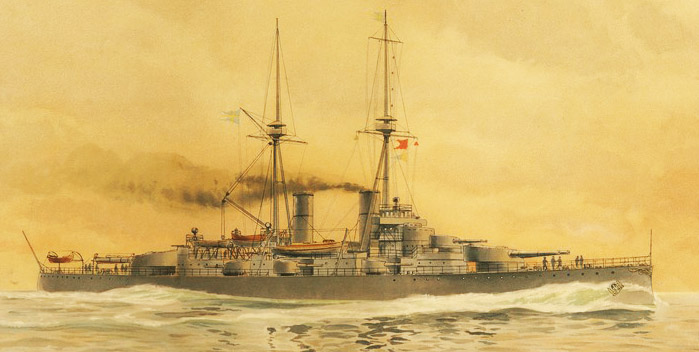
Rendition of the future Sverige in 1912 during the fundraising campaign, now at the Sjöhistoriska museet
Sweden witnessed the naval arms race after dissolving the union with Norway in 1905, tensions rose again with the Russian Empire, Germany, and Norway and by 1911, their ships were cruising around in the North Sea. In these circumstances, the Swedish Government only avalized the construction of Oscar II, a typical pre-dreadnought but with 8-inch guns for 17.8 knots and she was found totally inadequate, especially after the launch of HMD Dreadnought, likely to be followed by other nations.
The admiralty pushed fir a new class with extra seaworthiness, better armament, better protection and extra speed, and with the latest technologies, notably in fire control. In 1911, with the dreadnought race ongoing, the parliament voted at a small majority funds for the “F-boat” program the last of all proposals prepared and examined, A, B, C, D, D1, D2, E, E1, E2 and F, ranging from 4,800 to 7,500 metric tons and with various armaments and speed to match.
The Sverige-class coastal battleships were the largest ships ever to serve in the Swedish Navy at that point. Their design was totally new and inspired by other nations’ own dreadnought designs. Their armament was head and shoulders above the previous Oscar II (see below) with four 283 mm (11 in)/45 cal.
Bofors guns in twin turrets (rather than two 210 mm in single turrets) and eight 152 mm (6 in) Bofors guns a single superfiring twin turret and six single broadside made her battery. Just one on three of the Pansarkepp was ready on time to serve at the end of WW1 but all three formed the backbone of the Swedish Navy during WW2, next interwar constructions revolving around cruisers, destroyers, and submersibles.
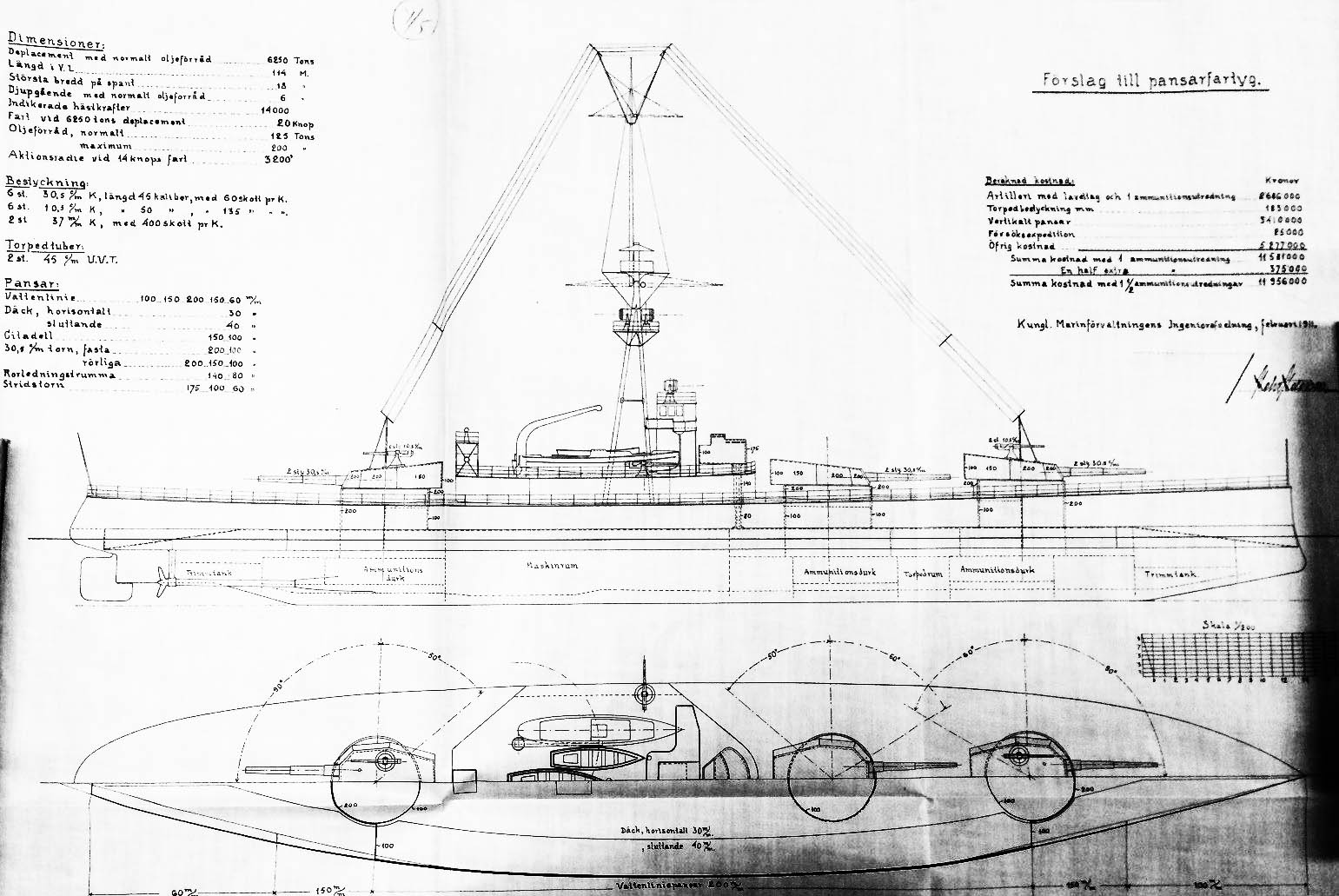
Enhanced swerige-class coastal battleship project, before the post-war ban of new constructions: She would have been armed with six 305 mm in twin turrets and six single 105 mm guns.
The Sverige-class was a new take on the coastal Defence ship, with an heavier armament, better speed, and armor. But still, the hull was tailored not for high seas but for local archipelagos and shallow waters. Their tactical doctrine and operations were also new. Indeed they formed the core of an open-sea battle group (which should have originally comprised four and not three ships), and were meant to operate with cruisers, destroyers, torpedo boats, but also air reconnaissance. This small battle group was to operate as a defensive force only.
Construction

Painting at the Sjohistoriska museet
“Sverige” (“Sweden”) was initially decided in 1911 to start the type F, submitted by the Admiralty, approved by the parliament. She was properly funded and voted. However, there was a change of government the next year. The new liberal majority prime minister Karl Staaff decided against new military spendings and against this ship. Thus, the project was postponed until an exhaustive analysis took place, before motivating any further decision.
However soon, a national move (parlty helped by a critical press and fuelled by international nationalism) a campaign was quickly setup to raise more money. In total, over 15 million crowns were gathered, and this helped the ship to be voted in 1911 (under a price bill of 12 million). This law was called the “Pansarbåtinsamlingen”. Breween the press, popular optinion, the parliament and funding, the government was cornered to authorize construction. The ship was also called called “the people’s gift to the country”.
The two next were voted in 1914 by the same government, now with a war to motivate it. These were called HMS Drottning Victoria and Gustav V. Both were laid down in 1915 due to material shortages, launched in September 1917 and January 1918 respectively. The war ended before any could be operational, but fortunately the country never left its neutrality stance. Both last vessels were completed in 1921 and 1922, modified with the experience from Sverige and modified in the interwar during completion.
Design of the Sverige class
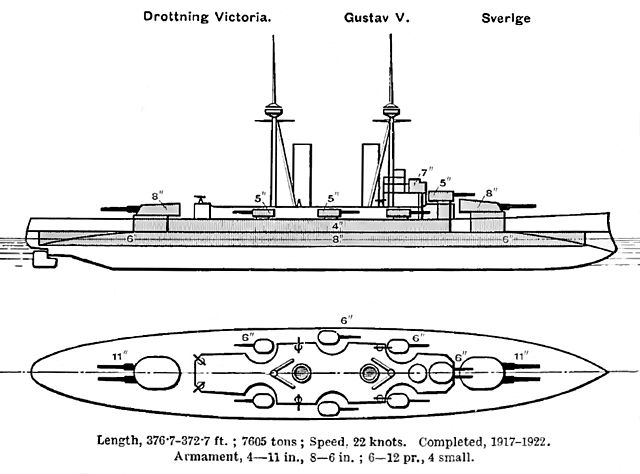
Brassey’s Naval annual armour scheme of the class, 1923
Hull and general design
The hull was 120 meters long (390 ft) for a 6,852 tons standard displacement which rose to 7,516 tons fully loaded for HSwMS Sverige, of another level also compared to Oscar II. Probably in 1914 they were the meanest coastal ship in any navy of the time, worthy of a “pocket dreadnought”. Other sources gives 6,961 tonnes tons standard, 7,758 tons deep load for Sverige initially.
With reconstruction and additions in WW2 they rose to 7,239 tonnes standard, 7,755 tonnes full load.
As for dimensions, her two sister ships were slightly different, at 121.6 m (399 ft) long, but the rest was the same at 18.6 m (61 ft) in beam and 6.2 m (20 ft) in draught but 6.3 m (21 ft) for Sverige.
Armour protection layout
Armor scheme included the following:
-200 mm (7.9 in) thick belt, central section tapered down to 100 mm (3.9 in) and 60 mm (2.4 in) both ends
-Upper belt 100 mm (3.9 in) behind fore barbette and aft barbettes.
-Main turret 200 mm (7.9 in) front, 100 mm (3.9 in) sides, 50 mm (2.0 in) roof.
-Main Barbettes 150 mm (5.9 in) above the ammo wells,
-Secondary turrets 125 mm (4.9 in), 100 mm (3.9 in) barbettes.
-Forward conning Tower 175 mm (6.9 in)
-Armor decks ranged from 45 to 30 mm (1.8 to 1.2 in).
All in all it was 50 mm more for all figures compared to Oscar II, sufficient to deal against Armoured cruisers of the time, but a bit light to face contemporary battleships.
Powerplant
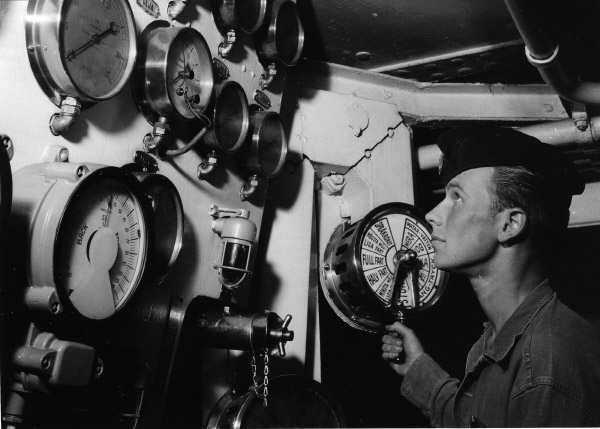
Engine telegraph on Drotting Victoria
To propel these 7,000 tons monsters, the machinery comprised four shafts coupled to Curtis turbines rated for 20,000 SHP total and 12 Yarrow-type coal-fired boilers. This figure was for the Sverige only. The two others had Westinghouse geared turbines rated for 22,000 SHP and were upgraded in the interwar to oil-fired models. The Westinghouse geared turbines manufactured by Motala Company for Gustaf V and Drottning Victoria, and rated for 22,000 SHP.
As for the range, Sverige carried initially 776 tons of coal, and later was added 100 tonnes of oil and it was 761 tons for the two sister ships (same for oil).
Armament
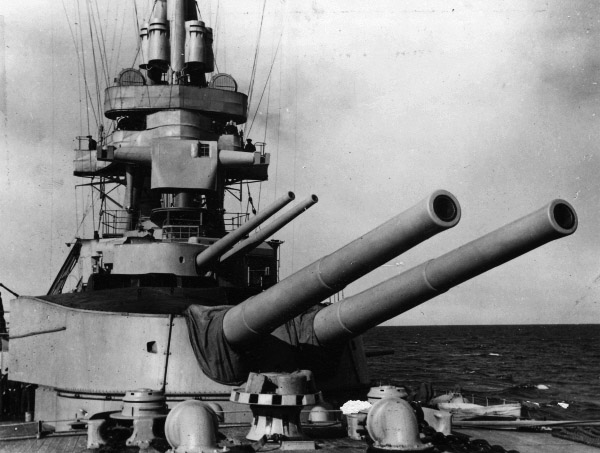
The armament comprised four 283 mm (11 in) 45 cal. Bofors that were equivalent to the German main battleship caliber of the time. The rate of fire was good at 17 sec. between shots but the turrets were rather cramped because of the partition between guns inside both turrets. The eight 6-in/50 caliber QF guns in twin and single turrets were rather a modern arrangement, more than usual broadside barbettes.
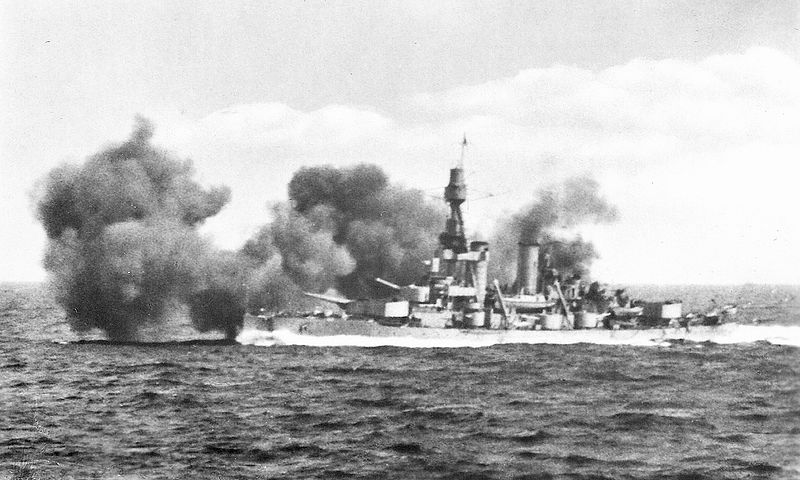
Main
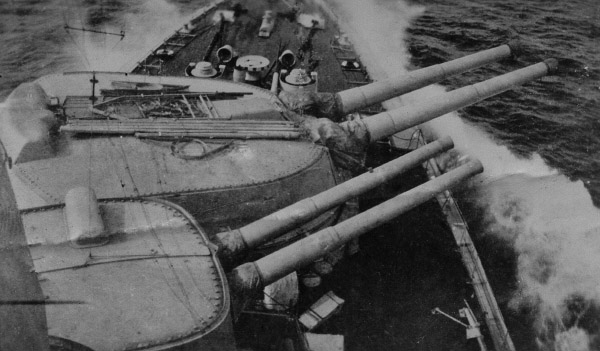
The Bofors 28.3 cm/45 (11.1″) Model 1912 were designed from 1912 for the Sverige class, and in service by 1917. Further projects of Pansarkepp were never followed-up in the interwar so they were the last. These guns were of built-up construction, with a hand-operated screw breech-block of the typical ogival type. They had a rather high rate of fire for the time (3-4 rounds per minute) and were considered to be quite accurate, making the ships quite a deterrent indeed for any capital ship.
In the 1930s a new and more aerodynamic “Arrow Nose Shell” was developed for increased range and compensate for the apparition of new, larger guns, notably in Germany the Schanrhorst’s 28 cm SK C/34 naval guns which had a 40,930 m (44,760 yd) at 40° elevation.
One of these guns (from Drottning Victoria) was preserved, now at the Karlskrona Naval Base.
They weighted 43.4 tons (44.1 mt) for a barrel lenght of 501.4 in (12.735 m), bore alone 484.1 in (12.295 m) and rifling of 414.0 in (10.515 m), 80 grooves.
They fired a Bagged type projectiles, 672.4 lbs. (305 kg) AP shells with a 220.5 lbs. (100 kg) charge.
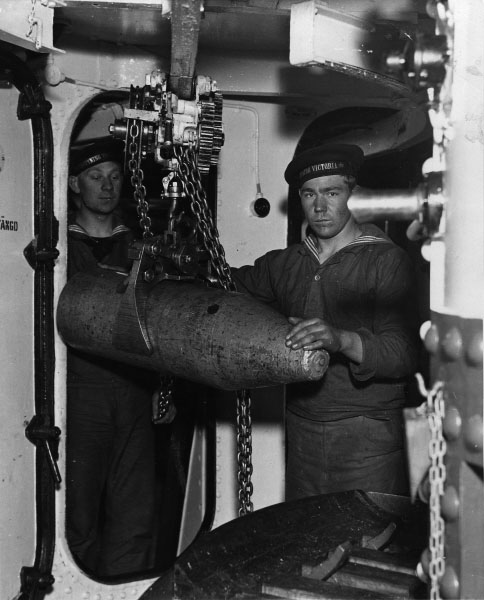

Muzzle Velocity was 2,854 fps (870 mps), enabling a range of 21,435 yards (19,600 m)/18° later ported with the 672.4 lbs. (305 kg) Arrow Nose shell to 31,700 yards (29,000 m) at 25°, after gun cradle modifications. The penetration at 6,560 yards (6,000 m) was 350 mm of hardened KC steel at 0° (13.77 in) and at 19,690 yards (18,000 m) 155 mm (6 in) down to 87 mm (3.4 in) on a horizontal armor. The 350 tonnes turret elevated initially to 18°, later to 25, at 5° per second and traversed at 4°. Gun axes were about 83 in (210 cm) apart to avoid interference.
Secondary
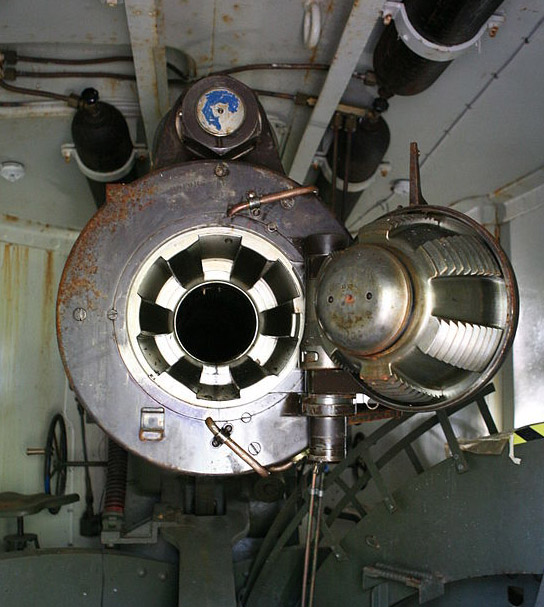
These eight 152 mm (6 in)/50 cal. guns were placed in a single twin turret forward, superfiring above the main 11-in forward turret, and six single mounts in single turrets, not unlike the British 1906 Lord Nelson class pre-dreadnoughts.
These 15.2 cm/50 (6″) Model 1912 were unique to the Sverige class. They were rather similar to the earlier Model 1903, used a hand-operated screw breech-block (ogival type).
In short, these 7.63 tons guns had a bore lenght of circa 300 in (7.620 m) and fired like the main guns at 3-4 rounds per minute.
They used a bagged AP 101 lbs. (46 kg) shell at 2,789 fps (850 mps) up to 15,000 yards (13,716 m) at 30° elevation.
Some ended after WW2 as land artillery, notably at the top secret “Kalix line” (northern Sweden), near Vuollerim in service until the 1990s amazingly. The fort was turned into a museum.
Tertiary
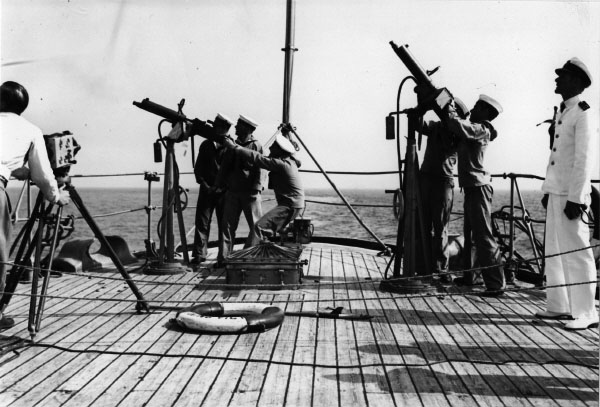
In addition, four 75 mm (3 in) Bofors AA cannons were mounted forward of the rear turret. No infos on these, even on the excellent navweaps.com.
There were also two anti-ship QF 57 mm (2.2 in) short-barreled Bofors and nine 6.5 mm (0.26 in) Machine-Guns
As customary for the time, the armament was rounded to two 457 mm (18 in) torpedo tubes.
⚙ specifications |
|
| Displacement | 6850 tonnes, 7700 tonnes FL |
| Dimensions | 120/122 x 18.6 x 6.25 m (390/399 x 61 x 20 feets) |
| Propulsion | 4 shafts, Kockums-Curtis Turbines, 12 Yarrow boilers, 20,000 shp |
| Speed | 22.5 knots as designed |
| Range | 2,720 nm at 14 knots |
| Armament | 4 x283, 8 (1×2, 6×1)x 152, 2x 75, 2x 57, 2x 6.5mm MG, 2x 450mm TTs |
| Protection | Belt 200, Barbettes 150, turrets 200, sec turrets 125, decks 45-30 mm, CT 175mm |
| Crew | 427 |
Reconstructions and modernizations
Sverige in 1929, before her major reconstruction
During WW2 this doctrine was still active and indeed they offered a smaller target to submarines, torpedo crafts or dive-bombers and minefields, some authors suggested they were taken in consideration in the decision by the Germans high command in WW2 not to invade Sweden in 1940. In fact, Jane’s 1938 edition classed these ships as battleships due to their use in a coherent battle group.
Machinery
The 12 Yarrow boilers were later upgraded to oil-fired boilers in the 1930s on Sverige, but not on Gustaf V and Drottning Victoria for strategic reasons. It was decided to keep the ability to burn coal if Swedish oil supply was cut off. Also after reconstruction they started to diverged widely in appearance:
Gustav V had funnels trunked into a single one, upper works well modified.
Sverige had her fore funnel trunked back away from the superstructure (also modified) but kept the second funnel.
Armament Upgrades
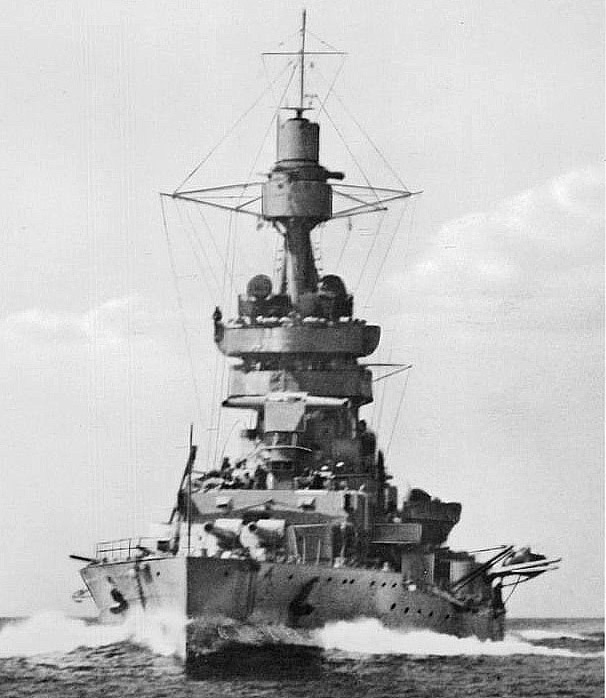
-The underwater torpedo tubes were removed and the room was converted into an artillery central, feeding data from modern range meters, coupled with new fire control systems for the heavy, secondary and AA-gunnery
-Small guns and two 6 in guns were removed. Modern Bofors 75mm, 40mm and 20mm AA guns were installed instead.
-Gustav V had her forward superfiring twin 152 mm (6 in) turret removed but a gyro-stabilized AA artillery (4×40 mm bofors) mount placed instead.
-Sverige and Drottning Victoria had their midship single 152 mm (6 in) guns removed, replaced by the same.
-Main 11 in guns range augmented, between the 25° elevation and new shells (as seen above).
-New complement reached 450, making these ships appear even more cramped. They were not popular in WW2, but still the country’s “insurance card” against a menacing Kriegsmarine.
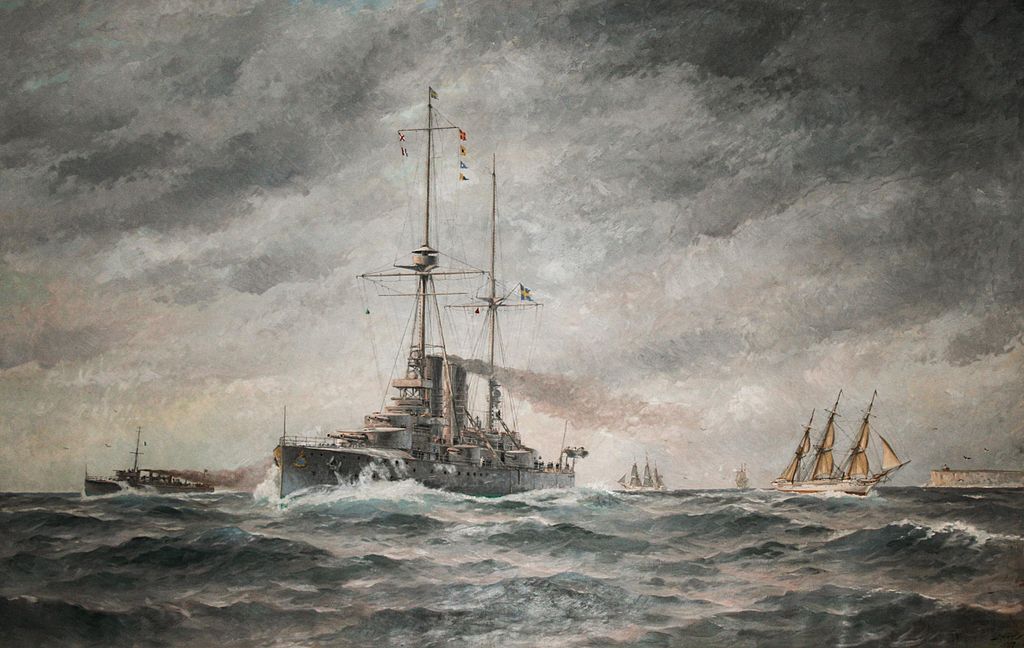
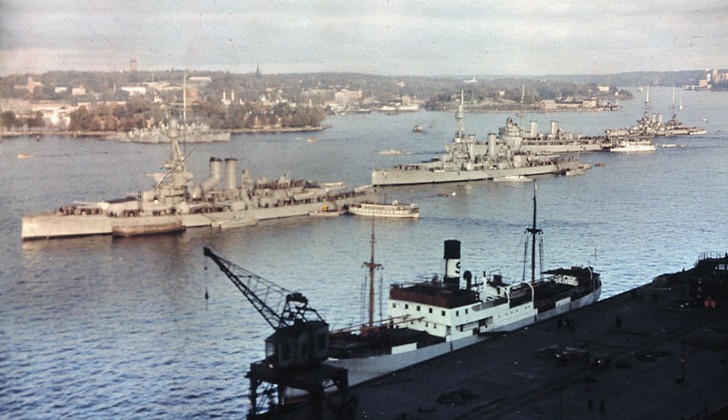
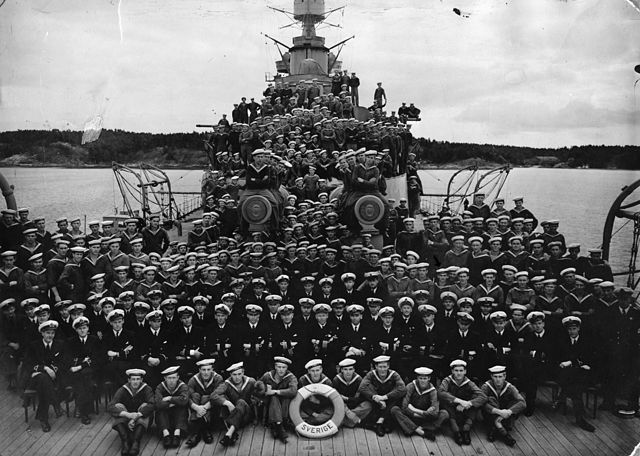
Modernization History
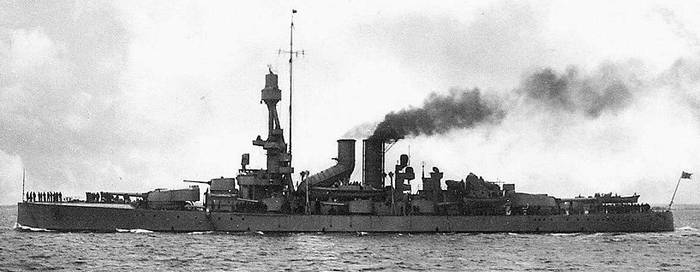
Sverige in 1931, in sea trials, post reconstruction
In 1924-1926 Sverige was given a new tripod mast, new director and fire-control centre and later on Drottning Victoria, same tripod mast and director, fire-control centre and both received paravanes. Gustav V was moderned later, between 1927 and 1930. Same midifications, but with her main mast cut and moved forward, delettion of six original 75mm/49 Bofors guns and addition of two twin 75mm/56 K/60 M28 guns.
In 1931-1937 all three saw radical armametn upgrades. Sverige received machinery and funnel modifications, mast too, new Curtis geared turbines and same armament upgrade as Gustav V.
It was the same for Drottning Victoria but she had 6 Yarrow mixed-burning boilers replaced by two oil-burning Penhöet, with fuel stowage modified to 360ts of coal and 273ts of oil. In additon to the twin 75mm/56 K/60 M28 she also received three single 25mm/55 K/58 M32 AA guns.
Gustaf V completed her prewar modernization last, with 6 Yarrow mixed-burning boilers replaced by two same oil-burning Penhöet (same figures) and same armament upgrade with in addition four single 25mm/55 K/58 M32 AA guns.
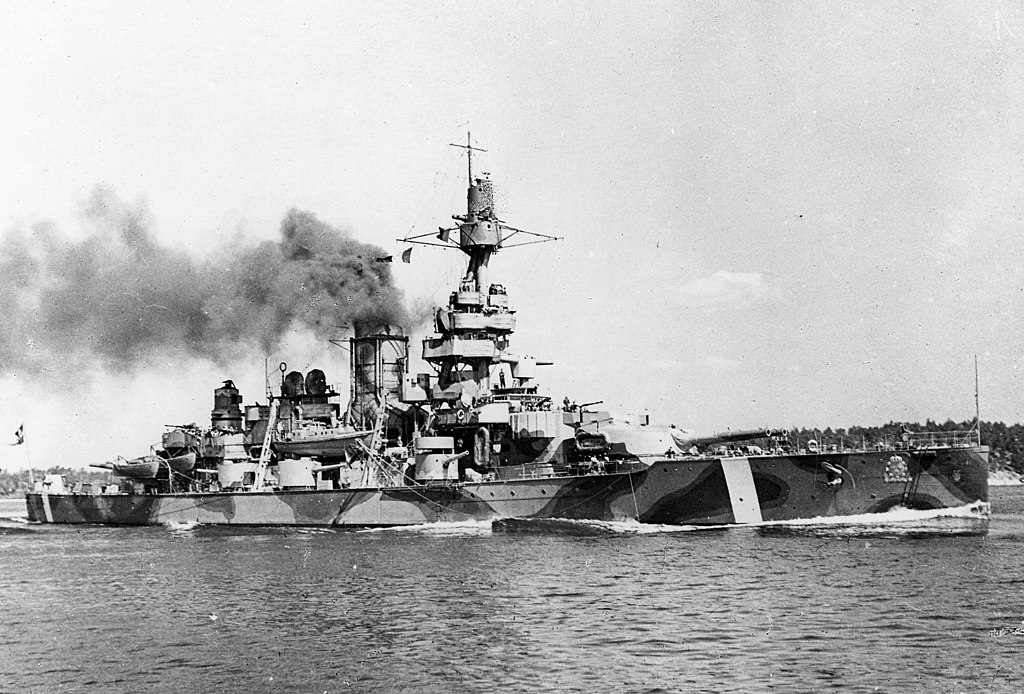
Gustav V in WW2
From 1938 and until 1942 they had limited upgrades. Sverige had four oil-burning Penhöet boilers installed, lost two 152mm/49 guns for two twin 40mm/56 K/60 M32, tw twin 25mm/55 K/58 M32 AA guns, and Drottning Victoria followed suite, but with two single 25mm/55 K/58 M32 and then twi more a year later.
In 1942 all three were upgraded again. Sverige had the two twin old 25mm/55 retired and instead a single twin 40mm/56 K/60 M32 installed as well as two twin 20mm/63 K/66 M40 (Licenced Oerlikon).
Drottning Victoria had all her seven 25mm/55 retired for the same, but instead of twio twin, seven 20mm/63 K/66 M40 (they replaced the 25 mm as a one-per-one basis).
Gustaf V had initially two twin and four single (8 total) 25mm/55 and they were all retired for four single 25mm/55, the twin 40mm Bofors and two twin plus four single 20mm/63 K/66 M40 AA guns.
In 1943 Drottning Victoria was the first equipped with a Swedish-built radar and after the war Gustaf V was equipped with a British radar. Sverige never received this upgrade.
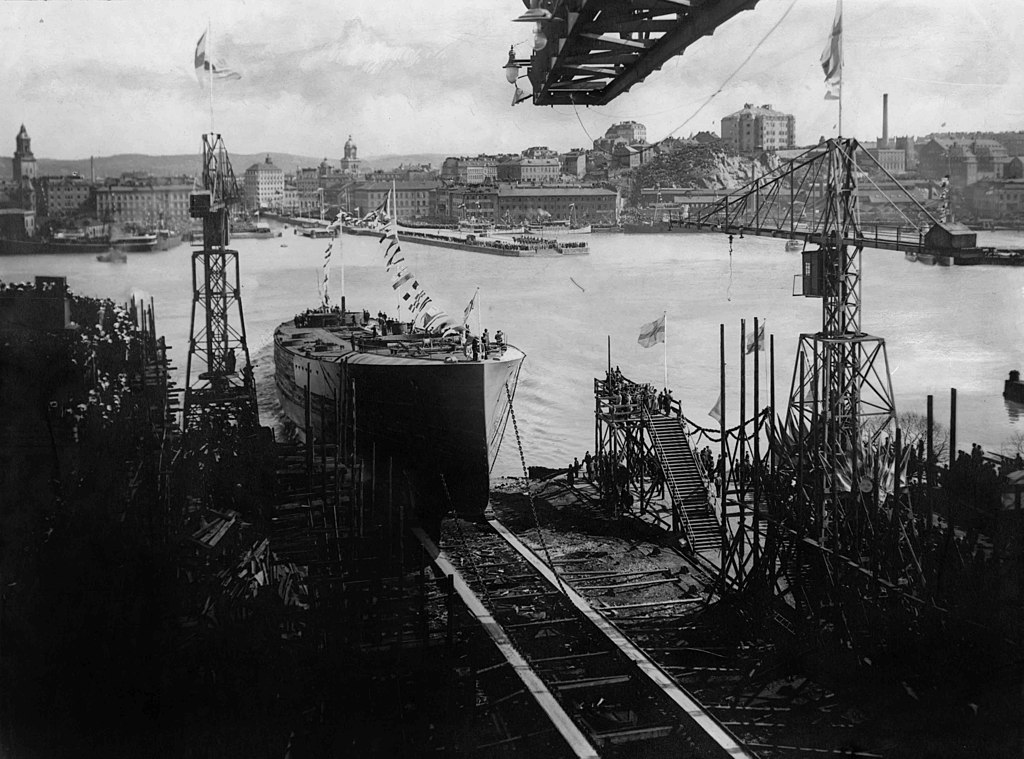
The launch of Sverige, on 3 May 1915, by then the largest, heaviest ship ever in Sweden. King Gustaf V and his family but also Prince Wilhelm, Prince Eugen and Prime Minister Hjalmar Hammarskjöld were in attendance. After a short speech, the king pressed a button which released the ship from the stack bed. The launch ended with a concert at Gothenburg’s concert hall, followed by a banquet at the stock exchange. During firring out, the 28 cm guns were too heavy for the existing crane and thus, two special cranes were built for the task in Gothenburg.
Total cost armounted to 13,450,000 crows, (SEK 350 million by 2009 value).
HSwMS Sverige the only ship of her class ready to take part in WW1. After completion in 10.5.1917 in Götaverken, Gothenborg. Sweden remaining neutral in two wars and between, their career was not outstanding, but interesting and quite long nonetheless.
 Sverige
Sverige
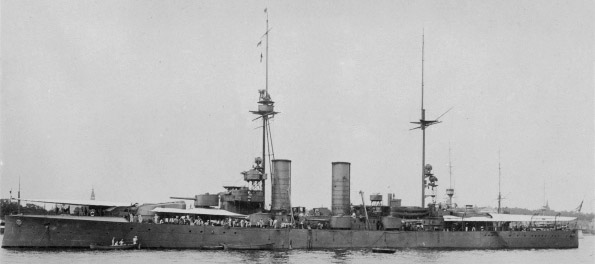
Sverige as completed
On May 10, 1917, the ship received her first crew and when fully equipped, departed with from Gothenburg to Karlskrona Royal Arsenal under command of captain Fredrik Riben, where she was to be docked for preparations and final acceptance sea trials. In Karlskrona it was found that her displacement was 90 tons less than calculated, which was something good for the standards of the time (it was often above). After ammunition and equipment were loaded, the new battleships left for Stockholm and dropped anchor on June 13, there and the following day, officialy commissioned with a grand ceremony.
The next months and in January 1918, she trained in home waters, including gunnery drills at the range, fleet manoeuvers and a short refit.
The Åland Expedition 1918:
As the war raged in Finland, by February 1918, it was requested fro Sverige to moved to the Åland islands, for protection against unrest. On February 13, a first expedition was sent there with the old HMS Thor. As the situation worsened, on the 17th both Sverige and Oscar II were sent to Åland. They sailed on the 18th after mustering crews and supplies, and arrived on the 20th at Arholma, waited into the ice, and were ordered afterwards to head directly towards Eckerö, Åland. Sverige monitored there the situation and helped evacuating civilians, together with the gunboat Svensksund.
The interwar:
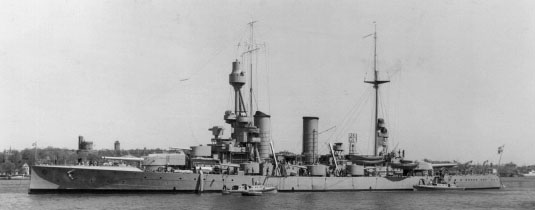
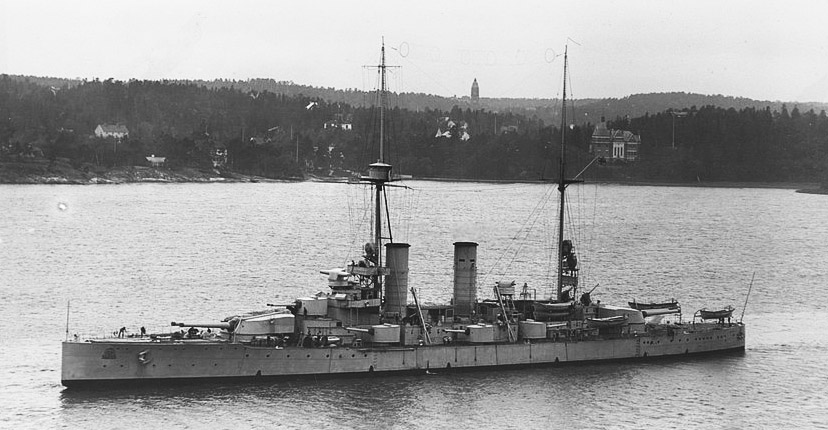
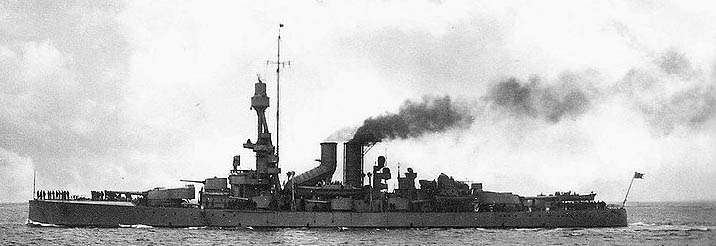
Sverige in 1929 and 1931
The spring and summer of 1918, saw the battleship back with the fleet as flagship, performing exercises on the west coast. As the Spanish flu ravaged the country, many ships were de facto out of commission, with quarantined, ill or absent crews. Every day steamboats picked sick sailors ashore and there were normal military funerals. On October 4, 1918, Sverige was in drydock refit at Karlskrona.
She took part in the celebrations of Crown Prince Gustaf Adolf’s marriage to Louise Mountbatten, with her sister HMS Drottning Victoria, escorted by the destroyers Wrangel and Wachtmeister in 1923 in England, joined by the cruiser Fylgia recalled from an overseas expedition, in Sheerness, by 2 July. Queen Victoria later visited Sweden, and assisted to rowing competitions against English ship crews.
In 1924–1925, Sverige was modernized a first time, quite extensively. By that time, her new captain was in 1926–1927 Gunnar Bjurner. The next one was performed in 1931–1933, and by 1936, she had her anti-aircraft artillery strengthened and further modernizations, plus new steam boilers. In 1938, all coal-fired boilers were removed and replaced by new oil-fired ones and this choice was dictated by the poor accuracy results when Drottning Victoria had to cancel an anti-aircraft exercise due to smoke interference, totally obscuring targets.
On March 15, 1939, Sverige returned to Karlskrona shipyard for another efit, with oil tanks installed and extra accomodations for the crew, new ammunition bins for the main and secondary artillery, new pole and boom, 110 cm gyro-stabilized headlights and 40 mm m/36 AA guns mounted.
Second World War
By September the other planned modifications were cancelled. On April 9, 1940, the ship was back in service with the coastal fleet.
She will soon have neutrality bands painted on her hull, like all other Swedish ships at the time. With the occupation of Denmark and Norway and weakening out of Finland, Sweden’s strategic position seemed jeopardized. The defense entire east coast needed to be defended, both against the Soviet Navy and the Kriegsmarine it seemed after the short-lived Germano-Russian pact.
On July 17, 1940, an explosion occurred in one of Gustav V’s boilers, ans since she was the flagship, it was transferred to Sverige, remaining so until the end of the war.
The winter of 1940/1941 was very severe and she was stuck in pack and it was decided to have the crews of all stuck Swedish ships trained to fight as infantry on ice in case of an invasion. Sverige also had her hull entirely sprayed with a lime-based white paint as a winter camouflage, possibly with black and white camouflage nets applied on her superstructure. Her appearance will change again in 1944.
On January 18, 1941, the submarine HMS Svärdfisken accidentally collided with Sverige while underwater and if the former suffered severe damage, towed by the battleships to Stockholm shipyard, the latter only sustained damage to her port inner propeller, shaft and struts. She was also drydocked for repairs. The remainder of 1942, 43 and 1944 so little action. She was moved from place to place depending on the evolving situation, notably receiving her final complex green-base camouflage, with several tones, something interneded for her to blend-in close to any archipelago island. When stationary camouflage netting was added to mask her superstructures.
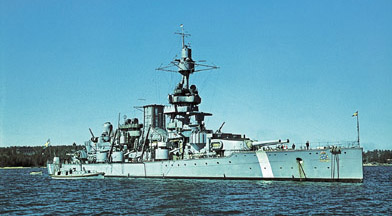
Sverige in WW2, with neutrality bands, prior to be camouflaged in 1942.
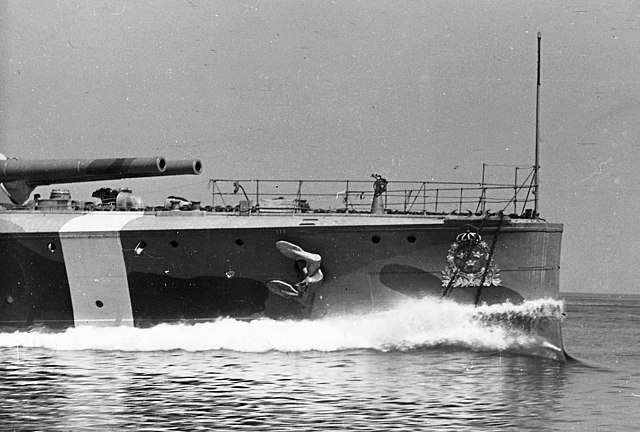
Sverige prow at full speed in 1944, showing her side crown.
On May 7, 1945, the war seemed over in Europe, the fleet’s constant battle readiness was maintained until the 16th, and it was decided to end the night blackouts. The fleet resumed her prepwar exercizes and activities. A refresher was needed, and Sverige took part on June 6, to a shooting competition. This was followed by the entire coastal fleet entering Stockholm. King Gustaf V came aboard Sverige distributed competition’s prizes, and to thank the officers and crews present for their vigilant guard during the war.
End of Career
By August 11, 1947, the now obsolete battleship was scheduled for decommission. Her flag insignia was lowered from her top mast for the last time. After decommission, Sverige was mothballed for a time, until stricken on 30 January 1953. Placed on the disposal list, she was sold in 1958 to a Swedish company and scrapped at Karlskrona. Since 1986, one of cannons is now exhibited at Rävåskullen, Karlskoga, placed there for the city’s 400th anniversary.
 Drottning Victoria
Drottning Victoria
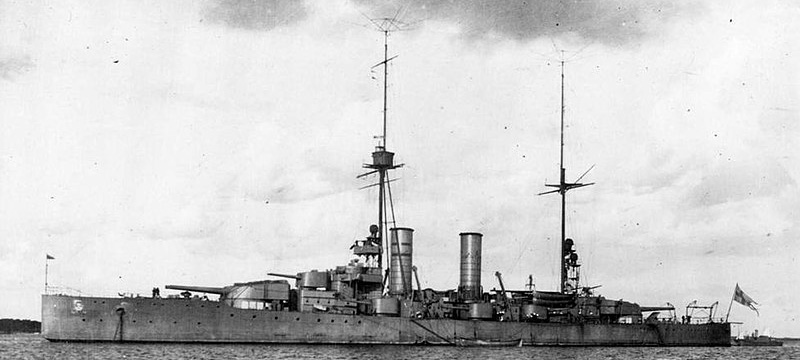
In early service, 1920s
“Queen Victoria” was launched at Götaverken on September 15, 1917. Her postwar-interwar service life resembled that of Sverige, with two major reconstructions and modernization, fleet training and ceremonial duties with Sverige.
Fast forward and Drottning Victoria during the winter of 1939–1940 was stuck by severe icing in the Horsfjärden area. Her crew was trained and reconverted as infantry in case of an invasion. In connection with reports of the Kriegsmarine movements ahead of Operation Weserübung, the Commander of the Coastal Fleet wanted Drottning Victoria and a fighter group to moved to open water as a deterrence.
As an amusing anecdote, on board the Drottning Victoria for a period there was the ship’s pet dog Nicke, a shaggy fox terrier who was taken care of by the crew. Nicke is mentioned in several places in the ship’s logs and had a specially made sailor’s suit and its own service book made. It appeared it was mustered on board on 1 January 1940 as a 3rd class seaman (ship number 900) and that he was later appointed corporal and then furrier according from October 31, 1943. Nicke remained on the ship at least until August 1946.
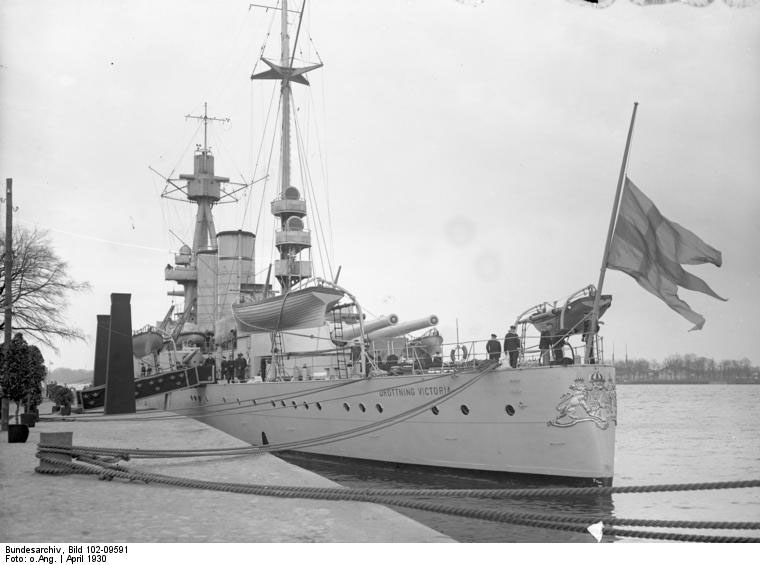

Drottning Victoria after 1931
Drottning Victoria was deactivated in 1948-49, stricken, and sold for scrap on March 22, 1957, then Scrapped in 1959 in Karlskrona.
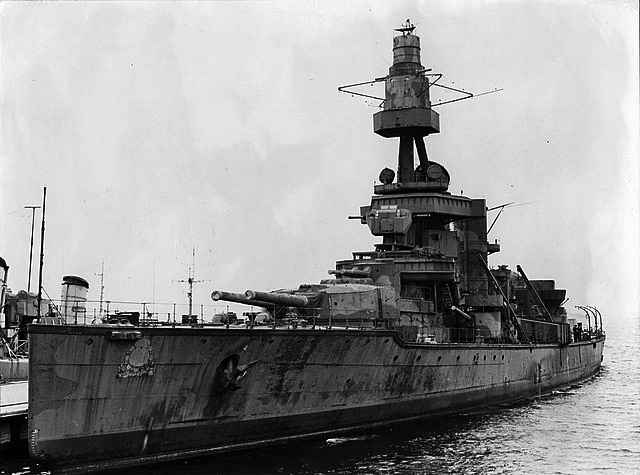
Drottning Victoria prior to deactivation in 1959
 HSwMS Gustav V
HSwMS Gustav V

Gustav V after 1930
HSwMS Gustaf V was built at Kockums Yards, in Malmö. The yard used Sverige’s original drawings and construction work went fast, without a hitch. Shortages of materials due to other priorities during the great war meant it lagged behind especially due to bottlenecks for equipments acquired outside the country. Armor plates notably were ordered from the United States, and arrived basically months out of schedule.
On 31 January 1918, she was launched and baptised by the wife of Crown Prince Gustaf VI Adolf. Due to the large, unprecedented size of the ship there was a legitimate fear it would slip at launch and hit the opposite side of the harbor basin, a short distance manageable by previous vessels, but not this one. To prevent this, heavy chains were attached to arrest her momentum. Also on the opposite side a “buffer” of wooden logs was installed to damp a possible collision. But the launch proved successful, the chains braking her mid-way as planned.
She was fitted out and still delays arose from material shortages compounded by a strong labor shortage in 1917–1920. It was so severe the yard requested to terminate the contract in the mood of disarmament and peace some even asking the removal of their armor and rebuilt Gustaf V and Drottning Victoria as passenger ships. By the winter of 1921/1922 however work resumed eventaually and both ships were completed as intended. Gustaf V started sea trials and showed her new machinery reduction gear worked well. It total her cost has been of 14,220,000 Swedish Krona (44,022,000 USD today). Some criticized her construction concept as being already obsolete and a waste of money. But 1,293,295 crowns were obtained by the Yard to cover increased costs from procurement delays.
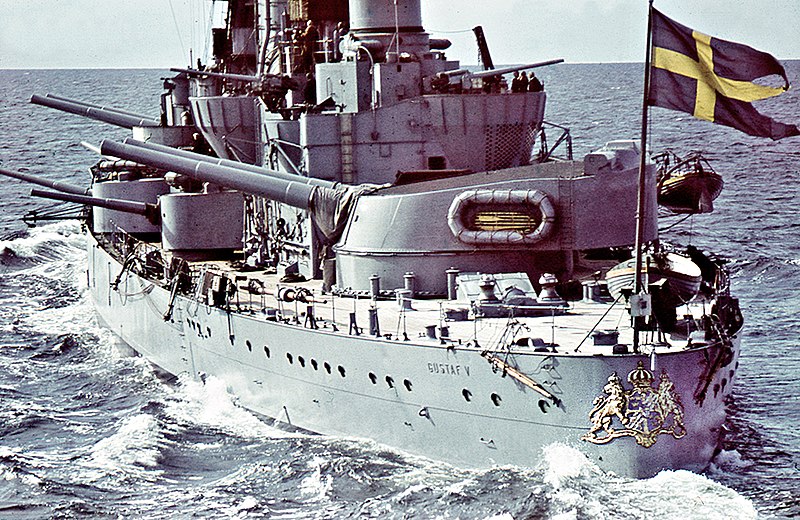
Aft view of Gustav V showing her Royal stern Crest, early WW2 as she has neutrality bands but is not camouflaged yet.
The early interwar new relations of Sweden with emergin states like Finland and the Baltic States, was accompanied by the Swedish Government’s goodwill and this led to several official exercises conducted in these countries. On 5 July 1924, Gustaf V and HSwMS Drottning Victoria, four minelayers went for example to Tallinn, and later the entire Swedish Coastal Fleet (36 ships) went to Helsinki. The summer of 1926 saw Gustaf V and Sverige visiting Copenhagen after exercizes in the southern Baltic.
In 1927–1930 Gustaf V her her first modernization.
After the death of Queen Victoria in the spring of 1930, Gustaf V and Drottning Victoria escorted by the destroyers HSwMS Ehrensköld and Nordenskjöld sailed to Swinemünde (9 April) to have the Queen’s remains carried onto HSwMS Drottning Victoria and they returned to Stockholm, the remains being landed and paraded on the royal barge Vasaorden.
On 4 April 1933, Gustaf V ran aground off Malmö but she was towed away on 6 April 1933 and repaired until the end of the year.
She her had second major modernization in 1936–1938 and on 9 March 1939, took part in a large air defense exercise out in Karlskrona. One aircraft attempting to land in the dark collided with Gustaf V’s combat mast. The crew was killed and the aicraft destroyed, but damage for the ship was negligible.
By 1939 Gustaf V being the most recent Swedish capital ship, she became flagship of the entire Coastal Fleet. On the night of 17 July 1940 during an exercise however, west of Gotland, she suffered a boiler explosion, which killed eight (the whole boiler room crew) and two on deck near one of the air intakes were badly burned. They were quickl evacuated by a minelayer to Visby Hospital, but one later died. While in Hårsfjärden it was decided by the commanding admiral to make HSwMS Sverige the new flagship, which she remained until the end of the war. Gustav V was repaired in Stockholm for a month and return to service. Nothing much happened during that time. Like Sverige and Drottning Victoria she had received neutrality white bands at the start of the war, and she was camouflaged by 1944.
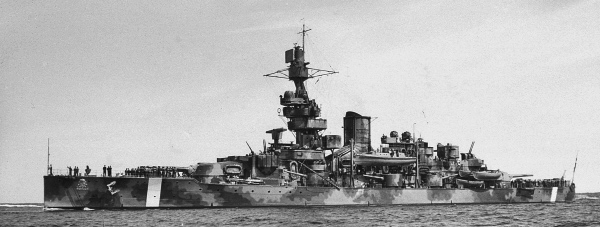
Gustav V in 1945, showing her newly installed radar.
After the war, Gustaf V took part in a ceremony held in Stockholm, being thanked by King Gustaf V for their “vigilant guard” during the war years. Indeed the crews had been mobilierf on high alert for the duration of WW2, with few rest or leaves, abbreviated refits, and a very high availability time. She returned to Karlskrona to received a new radar facility. HSwMS Sverige was discarded in in 1947 and Gustaf V took her place again as flagship.
It seems she served mostly as training ship for the remainder of the early cold war years, with the specter of a confrontation with the Soviet Batltic Fleet.
Gustaf V was the last Pansrkepp in service in the Swedish Navy -as for any navy- and she was stricken on 1 April 1957. She was mothballed at the Berga Naval Base, south of Stockholm until 1967 however, unlike the others. There, she was used as a mooring point for destroyers. Two her her secondary 6-in guns were removed to be installed into the secret Kalix Line in Norrbotten, placed in Häggmansberget casemate.
In 1970 at last, the very last coastal battleship in the world was sold for BU in Gothenburg. This is rather sad that she was not preserved as a floating museum, but this was still rare in the late 1960s (and costly).
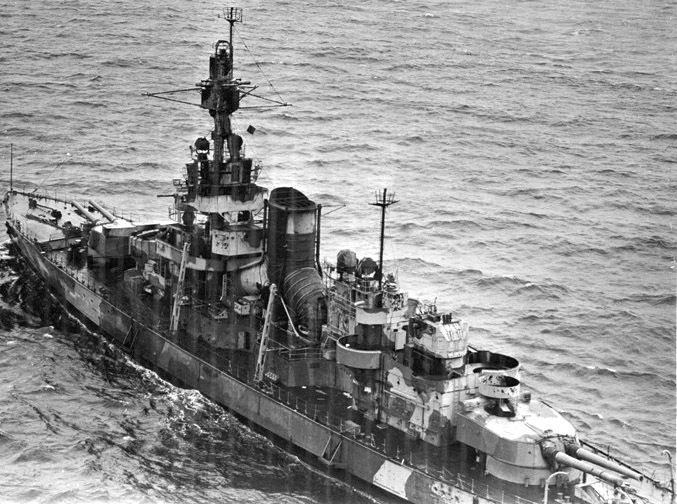
Gustav V towed for scrapping in Gothenburg. She still sported her wartime camouflage, something that became a feature of the Swedish Fleet in the cold war as well.
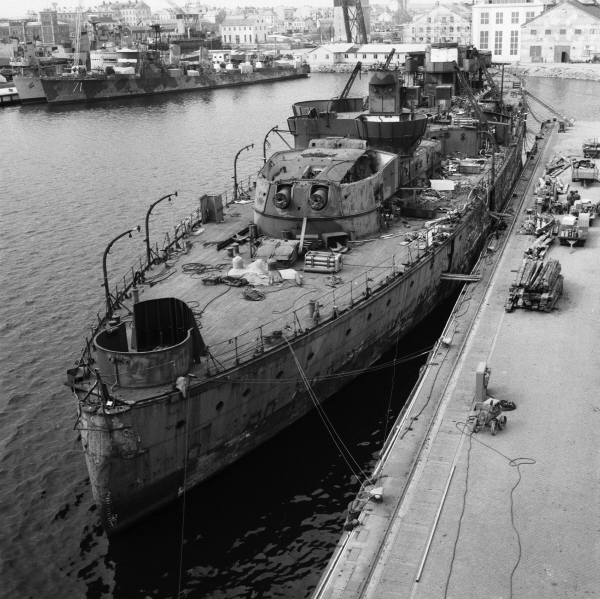
The same in scrapping
Read More

Rare original color photo, camouflaged in 1944 of Drottning Victoria (small size, cc).
Books
Naval Weapons of World War Two” by John Campbell
Från monitorer till pansarskepp” by Per Insulander and Curt S. Ohlsson
Harris, Daniel G. (1992). “The Svierge Class Coastal Defense Ships”. In Gardiner, Robert (ed.). Warship 1992. NIP
Hore, Peter; Ireland, Bernard (2013). The Illustrated Encyclopedia of Battleships & Cruisers. Anness.
Sundberg, Ulf (2018). “The heavily Armoured ShipSverige (1915)”. In Taylor, Bruce (ed.). The World of the Battleship. Seaforth Publishing.
Utredning och Forslag angaende Sjorkrigsmaterielens sammansättning m.m. avgivet jamlikt Kungl. Swedish National Archives
Links
navweaps.com 11-in/45 1912
navweaps.com 6-in/50 m1912
navypedia.org/ sverige class
commons.wikimedia.org Sverige_class cc photos
Videos
3D
Model Kits
3D printed modellbauray Sverige class 1:700
On scalemates: Fairy Kikaku 1:700, in addition to modellbauRay. That’s it.

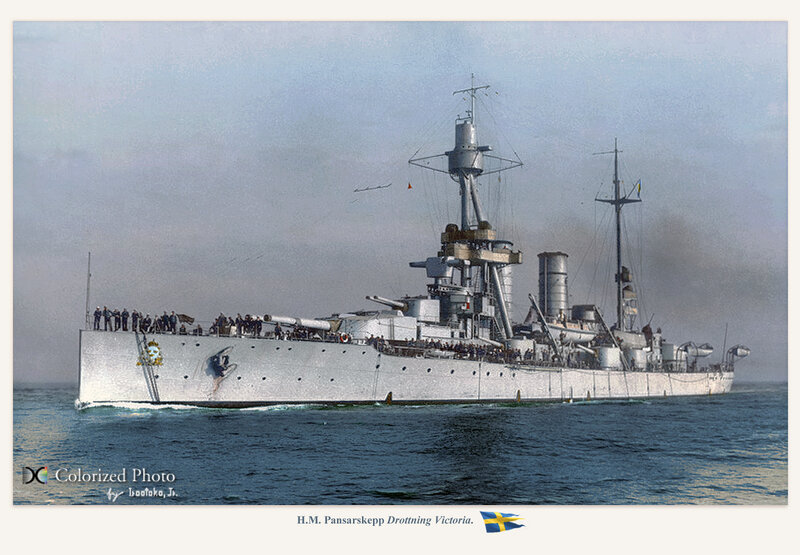
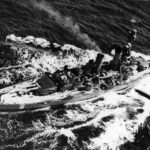

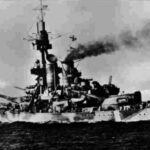
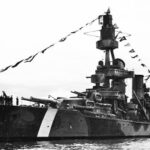
 Latest Facebook Entry -
Latest Facebook Entry -  X(Tweeter) Naval Encyclopedia's deck archive
X(Tweeter) Naval Encyclopedia's deck archive Instagram (@navalencyc)
Instagram (@navalencyc)





 French Navy
French Navy Royal Navy
Royal Navy Russian Navy
Russian Navy Armada Espanola
Armada Espanola Austrian Navy
Austrian Navy K.u.K. Kriegsmarine
K.u.K. Kriegsmarine Dansk Marine
Dansk Marine Nautiko Hellenon
Nautiko Hellenon Koninklije Marine 1870
Koninklije Marine 1870 Marinha do Brasil
Marinha do Brasil Osmanlı Donanması
Osmanlı Donanması Marina Do Peru
Marina Do Peru Marinha do Portugal
Marinha do Portugal Regia Marina 1870
Regia Marina 1870 Nihhon Kaigun 1870
Nihhon Kaigun 1870 Preußische Marine 1870
Preußische Marine 1870 Russkiy Flot 1870
Russkiy Flot 1870 Svenska marinen
Svenska marinen Søværnet
Søværnet Union Navy
Union Navy Confederate Navy
Confederate Navy Armada de Argentina
Armada de Argentina Imperial Chinese Navy
Imperial Chinese Navy Marinha do Portugal
Marinha do Portugal Mexico
Mexico Kaiserliche Marine
Kaiserliche Marine 1898 US Navy
1898 US Navy Sovietskiy Flot
Sovietskiy Flot Royal Canadian Navy
Royal Canadian Navy Royal Australian Navy
Royal Australian Navy RNZN Fleet
RNZN Fleet Chinese Navy 1937
Chinese Navy 1937 Kriegsmarine
Kriegsmarine Chilean Navy
Chilean Navy Danish Navy
Danish Navy Finnish Navy
Finnish Navy Hellenic Navy
Hellenic Navy Polish Navy
Polish Navy Romanian Navy
Romanian Navy Turkish Navy
Turkish Navy Royal Yugoslav Navy
Royal Yugoslav Navy Royal Thai Navy
Royal Thai Navy Minor Navies
Minor Navies Albania
Albania Austria
Austria Belgium
Belgium Columbia
Columbia Costa Rica
Costa Rica Cuba
Cuba Czechoslovakia
Czechoslovakia Dominican Republic
Dominican Republic Haiti
Haiti Hungary
Hungary Honduras
Honduras Estonia
Estonia Iceland
Iceland Eire
Eire Equador
Equador Iran
Iran Iraq
Iraq Latvia
Latvia Liberia
Liberia Lithuania
Lithuania Mandchukuo
Mandchukuo Morocco
Morocco Nicaragua
Nicaragua Persia
Persia San Salvador
San Salvador Sarawak
Sarawak Uruguay
Uruguay Venezuela
Venezuela Zanzibar
Zanzibar Warsaw Pact Navies
Warsaw Pact Navies Bulgaria
Bulgaria Hungary
Hungary

 Bundesmarine
Bundesmarine Dutch Navy
Dutch Navy Hellenic Navy
Hellenic Navy Marina Militare
Marina Militare Yugoslav Navy
Yugoslav Navy Chinese Navy
Chinese Navy Indian Navy
Indian Navy Indonesian Navy
Indonesian Navy JMSDF
JMSDF North Korean Navy
North Korean Navy Pakistani Navy
Pakistani Navy Philippines Navy
Philippines Navy ROKN
ROKN Rep. of Singapore Navy
Rep. of Singapore Navy Taiwanese Navy
Taiwanese Navy IDF Navy
IDF Navy Saudi Navy
Saudi Navy Royal New Zealand Navy
Royal New Zealand Navy Egyptian Navy
Egyptian Navy South African Navy
South African Navy






























 Ukrainian Navy
Ukrainian Navy dbodesign
dbodesign